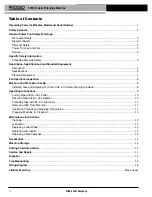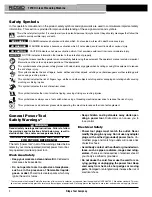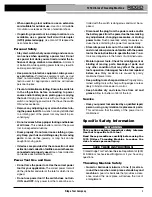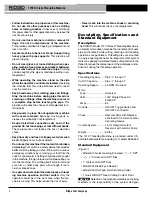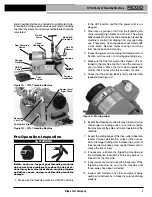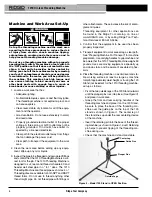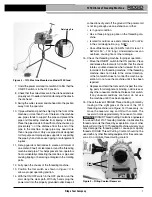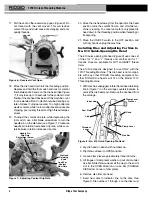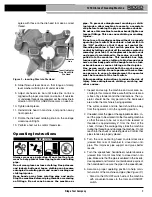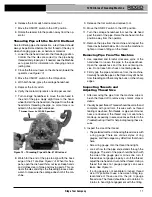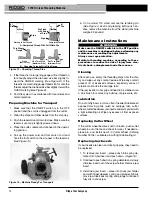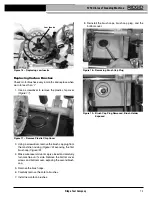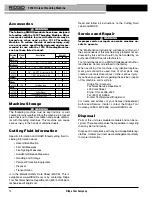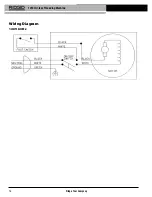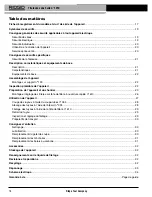
•
When operating a tool outdoors, use an extension
cord suitable for outdoor use.
Use of a cord suitable
for outdoor use reduces the risk of electrical shock.
•
If operating a power tool in a damp location is un-
avoidable, use a ground fault circuit interrupter
(GFCI) protected supply.
Use of an GFCI reduces the
risk of electric shock.
Personal Safety
•
Stay alert, watch what you are doing and use com-
mon sense when operating a power tool. Do not
use power tool while you are tired or under the in-
fluence of drugs, alcohol, or medication.
A moment
of inattention while operating power tools may result in
serious personal injury.
•
Use personal protective equipment. Always wear
eye protection.
Protective equipment such as dust
mask, non-skid safety shoes, hard hat, or hearing pro-
tection used for appropriate conditions will reduce
personal injuries.
•
Prevent unintentional starting. Ensure the switch is
in the off-position before connecting to power
source and/or battery pack, picking up or carrying
the tool.
Carrying power tools with your finger on the
switch or energizing power tools that have the switch
ON invites accidents.
•
Remove any adjusting key or wrench before turn-
ing the power tool ON.
A wrench or a key left attached
to a rotating part of the power tool may result in per-
sonal injury.
•
Do not overreach. Keep proper footing and balance
at all times.
This enables better control of the power
tool in unexpected situations.
•
Dress properly. Do not wear loose clothing or jew-
elry. Keep your hair and clothing away from moving
parts.
Loose clothes, jewelry, or long hair can be
caught in moving parts.
•
If devices are provided for the connection of dust
extraction and collection facilities, ensure these are
connected and properly used.
Use of dust collection
can reduce dust-related hazards.
Power Tool Use and Care
•
Do not force the power tool. Use the correct power
tool for your application.
The correct power tool will
do the job better and safer at the rate for which it is de-
signed.
•
Do not use power tool if the switch does not turn
it ON and OFF.
Any power tool that cannot be con-
Ridge Tool Company
3
1210 Oil-less Threading Machine
trolled with the switch is dangerous and must be re-
paired.
•
Disconnect the plug from the power source and/or
the battery pack from the power tool before making
any adjustments, changing accessories, or storing
power tools.
Such preventive safety measures re-
duce the risk of starting the power tool accidentally.
•
Store idle power tools out of the reach of children
and do not allow persons unfamiliar with the power
tool or these instructions to operate the tool.
Power
tools are dangerous in the hands of untrained users.
•
Maintain power tools. Check for misalignment or
binding of moving parts, breakage of parts and
any other condition that may affect the power
tool’s operation. If damaged, have the tool repaired
before use.
Many accidents are caused by poorly
maintained power tools.
•
Keep cutting tools sharp and clean.
Properly main-
tained cutting tools with sharp cutting edges are less
likely to bind and are easier to control.
•
Keep handles dry and clean; free from oil and
grease.
Allow for better control of the tool.
Service
•
Have your power tool serviced by a qualified repair
person using only identical replacement parts.
This will ensure that the safety of the power tool is
maintained.
Specific Safety Information
WARNING
This section contains important safety informa-
tion that is specific to this tool.
Read these precautions carefully before using the
1210 Oil-less Threading Machine to reduce the
risk of serious personal injury.
SAVE THESE INSTRUCTIONS!
Contact Ridge Tool Technical Service Department at (800)
519-3456 or [email protected] if you have any
questions.
Threading Machine Safety
•
Guard or barricade minimum of one (1) metre a-
round the area when work piece extends beyond
machine.
A guard or barricade that provides a clear-
ance around the work piece will reduce the risk of
entanglement.


